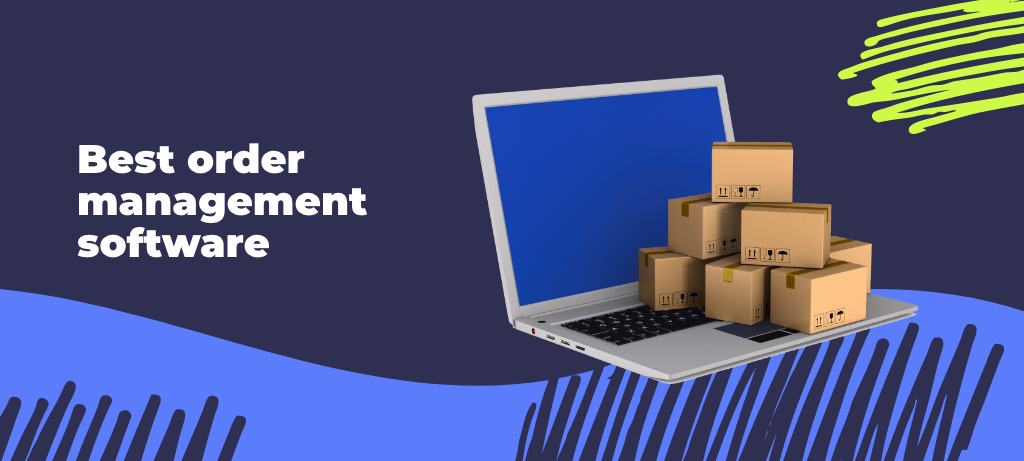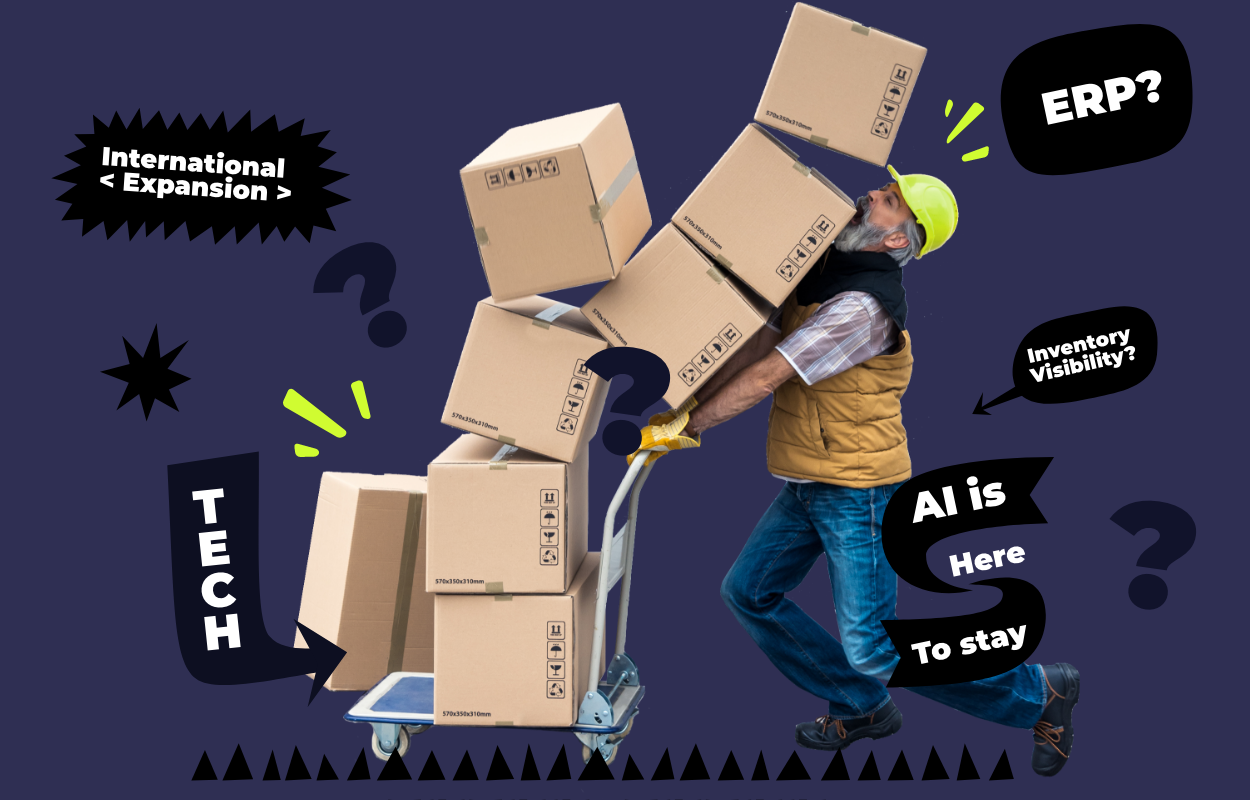How to find and use the best order management software for your ecommerce business

Ecommerce is driving the future of shopping and transforming the supply chain.
Global ecommerce sales are on track to reach $6 trillion this year, led by China and the United States. By 2027, almost half of all retail could happen online, highlighting the incredible growth of ecommerce order management, inventory management, and digital workflows.
In a fast-moving industry, how you manage your supply chain can set you apart—or leave you behind. The big names in online retail already rely on advanced order management software and enterprise-level inventory systems to maintain their edge.
So, how can a small business or growing B2B ecommerce venture keep up in such a competitive space?
Choosing the right order management system (OMS) helps you streamline your operations, deliver better customer experiences, and compete effectively, even against larger players. The best part? Great order management software is within reach for smaller ecommerce retailers ready to take the next step.
In this guide, you’ll learn how to find and use the best order management software for your business. We’ll cover:
- What an order management system is
- Why you need an order management system
- The benefits of using order management software
- Key features of top ecommerce order management software
- How to create a shortlist of the right OMS options
- How to select and implement the best solution for your business
Let’s start with the essentials and work our way forward.
What is an order management system?
Finding the right order management software can feel overwhelming if you’re new to OMS solutions. We get it: it’s a big step, but it doesn’t have to be complicated.
An order management system automates and organizes your entire order fulfillment process, from placement to delivery and returns. The best order management systems integrate seamlessly with all your sales channels, creating a connected experience for faster, more accurate fulfillment—and happier customers. Effective multichannel order management covers:
- Order routing
- Inventory synchronization
- Shipping and returns
- Data aggregation and reporting
The Linnworks shipping and fulfillment report
Learn how ecommerce brands cut costs, improve delivery speed, optimize carriers and streamline operations.

Why you need an order management system: TL;DR
The right order management software solves one of ecommerce’s biggest pain points.
What’s that pain point?
If your customers have issues with their orders, they’re less likely to return for repeat business. You’ll also lose out on word-of-mouth referrals, which are essential for growth—happy customers generate a return on investment that’s 3–5 times higher than non-referred ones.
Knowing what to order, when to reorder, where to keep your stock, and where your orders are at any time quickly gets complicated. That’s where an OMS comes in. It automates your processes, improves your customer experience, makes your inventory visible, enables smarter forecasting, and supports your bottom line.
While some small businesses get by with spreadsheets, that approach is not sustainable for serious growth.
If you want to build a strong online business, you need an OMS to stay competitive in today’s ecommerce landscape.
Why you need an order management system: the detailed breakdown
Let’s look at the specific benefits of order management software.
Improved efficiency
Efficiency isn’t just a trend, it’s what drives your business forward. A well-chosen OMS automates repetitive tasks, saving you time to focus on growing your business.
Save time and avoid errors – Automate key processes like order entry, inventory updates, and shipping notifications. This means fewer manual tasks, reduced risk of mistakes, and direct cost savings. Even small errors can become expensive over time, costing businesses millions every year.
Integrate with the tools you use – Your OMS becomes the hub of your operations, connecting with ecommerce platforms, accounting software like QuickBooks Online, ERP (enterprise resource planning), and CRM (customer relationship management) systems. This keeps your business running smoothly and reduces manual input.
Linnworks demo for established retailers and brands
Optimize your ecommerce tech stack to eliminate inefficiencies and streamline your online selling process.

Enhanced customer experience
Customers expect speedy, seamless service. The right order management software helps you deliver—no matter how busy you get.
Fast, accurate fulfillment – Your OMS keeps every order moving efficiently, so your customers get what they want on time, every time.
Real-time tracking and notifications – Keep your customers updated at every stage. Built-in tracking lets you share shipping and delivery info automatically.
Scalability
A flexible OMS grows with you, helping you seize new sales opportunities easily.
Handle higher order volumes – Scale up as sales increase. Most OMS solutions are built to manage growing demand, so your operations keep running smoothly.
Expand to new channels and marketplaces – The best systems integrate with platforms like QuickBooks Commerce or SAP Commerce Cloud, supporting your sales wherever your customers are.
Cost savings
Smarter systems save money by doing more with less—so you keep more of your revenue.
Lower labor costs – Automation reduces routine work, freeing your team to focus on sales and growth, reducing errors along the way.
Cut overhead – Advanced inventory tools help you cut storage, avoid excess warehouse space, and keep stock levels just right.
- Save on storage – No need for unnecessary warehousing
- Lower shipping costs – Automated tools find the best rates
- Avoid stockouts or overstocking – Stay balanced and efficient
State of your commerce quiz
How do your ecommerce operations stack up? Take our quiz to see where you stand and get actionable next steps to improve your workflows.

Key features of the best order management software: your checklist
Order management systems can look complex, but these are the essentials you should look for:
- User-friendly dashboard with centralized data
- Multichannel order management (like Linnworks OMS and Salesforce Agentforce Commerce)
- Warehouse management system (WMS) integration
- Real-time inventory tracking and control
- Automated order processing and fulfillment
- Workflows you can customize for your needs
- Real-time analytics and reporting (sales, inventory, customer behavior, etc.)
- Strong data security and compliance features
- Personalized onboarding, training, and ongoing support
Top tip for OMS shopping
No, we’re not going to go all cheesy on you with the whole ‘buy cheap, buy twice’ false economy mantra. Although, in fairness, there is some merit to that when looking for the most cost-effective solutions.
You see, the primary factor to bear in mind is that the decision you make right now isn’t just about having an order management system—it’s about selecting a scalable, future-ready order management solution that fits your inventory management software requirements.. You want to pick the best ecommerce order management software that will also support your future goals with minimum disruption. So, spending a little extra in the short term may be worth it to avoid repeating the process down the line when you outgrow your starter software.
Linnworks demo: fully integrated fulfillment solutions
Streamline operations, enhance accuracy, and automate processes for better efficiency.

How to shortlist the best order management systems for your business
Ready to start looking? Here’s a step-by-step approach:
1. Assess your business needs
- Identify your order and inventory management challenges
- Decide which features matter most to your team and workflows
2. Research and compare
- Look for proven providers with solid reputations
- Compare systems by features, pricing, and customer reviews
3. Check integration capabilities
- Make sure the OMS connects with your current tools (ERP, accounting, CRM, etc.)
- See if APIs or other integration options exist for custom solutions
4. Evaluate ease of use
- Choose intuitive, user-friendly software
- Consider your team’s learning curve and training needs
5. Prioritize scalability
- Select options designed for growth
- Flexible pricing plans help you scale as sales and orders increase
The best order management software for ecommerce operators
At Linnworks, we focus on making order management simple and effective. Our team has helped businesses improve their inventory, fulfillment, and customer care for years. In 2022, we merged with SkuVault, bringing together deep experience and innovative solutions for more complex sales and warehousing needs.
What sets Linnworks and SkuVault Core apart? We work as your partner, simplifying ecommerce operations, driving efficiency, and helping your business reach its potential.
Linnworks order management software helps growing businesses automate workflows, track orders in real time, and handle purchase orders with ease—integrating with over 100 leading platforms. You can build tailored processes and access key business insights. Highlights include:
- Automated order processing and fulfillment
- Automated inventory replenishment for optimal stock levels
- Invoicing and purchase orders generated automatically to save admin time
- Actionable business reporting
- Expert onboarding, training, and 24/7 support
SkuVault Core eliminates manual guesswork with an integrated inventory management and warehouse management system. Easily track orders, streamline workflows, and automate tasks for faster, more accurate fulfillment. Benefits include:
- Simple pick, pack, and ship workflows with barcode scanning
- Real-time analytics covering inventory at every location
- Automatic quantity updates across marketplaces
- Clear, detailed reporting for data-driven decisions
- Full customer support and online resources, whenever you need them
Implementation
When you work with Linnworks, you get a dedicated implementation partner to guide your order management journey. We provide:
- A detailed timeline tailored to your needs
- Clear resource allocation plans
- Risk analysis covering disruption, security, and compliance
- Training for your whole team
- Continuous workflow optimization to ensure long-term efficiency
- Performance metrics to track results and deliver on our commitments
- Ongoing support and resources
Curious to learn more? Request a demo or contact us to speak with our experts and explore how we can help your business thrive.
FAQs
The best order management software is one that centralizes order processing, inventory management, order tracking, and order fulfillment into one connected workflow. A strong OMS should automate repetitive tasks, reduce manual processes, provide real-time inventory visibility, and support multiple sales channels.
An order management system streamlines the entire lifecycle of a customer order. This includes order placement, order entry, inventory syncing, order routing, fulfillment, shipping updates, and returns management. A modern OMS also connects with other business tools such as e-commerce platforms, accounting systems, and warehouse operations to ensure a seamless, accurate flow of data.
As order volume grows, an OMS prevents errors caused by manual order processing and fragmented workflows. It helps businesses maintain accurate inventory levels, avoid overselling, improve fulfillment speed, and enhance customer experience with reliable order status updates. For scaling brands, an OMS is essential for operational efficiency and long-term growth.
An OMS provides centralized inventory tracking, automated stock updates, replenishment alerts, and detailed visibility across all warehouses or locations. This ensures sellers always know what’s available, where it’s stored, and when to reorder. This supports better inventory forecasting, reduces stockouts, and improves inventory turnover.
Yes. A modern OMS should offer seamless integration with major ecommerce platforms, sales channels, shipping carriers, and business tools. These integrations synchronize orders, inventory, customer information, and sales reports, eliminating duplicate data entry and ensuring consistent, accurate information across the entire operation.
An OMS enhances customer satisfaction by ensuring fast, accurate order fulfillment, providing real-time order tracking, and preventing issues like overselling or shipping delays. It consolidates customer and order data, making it easier to communicate updates and maintain the level of reliability customers expect.
A strong OMS should offer:
• Centralized, multichannel order management
• Real-time inventory management
• Automated order processing
• Intelligent order routing
• Warehouse management integrations
• Returns management
• Comprehensive analytics and reporting
• Mobile access for visibility on the go
• Easy integration with your existing ecommerce ecosystem
These features help streamline operations and support future growth.
An OMS helps automate and coordinate each step of the order fulfillment process, from picking and packing to shipping and updating order status. It assigns orders to the correct fulfillment location, ensures inventory is accurate, and reduces delays—resulting in faster, more efficient fulfillment.
Yes. An OMS provides structured workflows to manage returns, update inventory availability, and maintain accurate records. By creating a clear returns process, businesses can reduce errors, speed up restocking, and provide a smoother customer experience.
Automated order processing uses rules-based workflows to handle tasks like order entry, inventory adjustments, order routing, and shipping documentation. Automation reduces human error, accelerates fulfillment, and helps businesses stay efficient even as order volume increases.
Yes. Multichannel support is a core capability of modern order management systems. An OMS consolidates customer orders from all connected channels into one location, ensuring consistent inventory levels, faster fulfillment, and accurate reporting across the entire business.
An OMS is built for growth. It supports higher order volume, additional warehouses, new sales channels, and more complex workflows. Real-time inventory updates, automation, and connected data help businesses expand operations without sacrificing speed or accuracy.
An OMS manages the entire flow of an order, while a WMS focuses specifically on warehouse operations like picking, packing, and stock control. Many businesses use an integrated approach, where both systems work together to optimize warehouse operations, inventory accuracy, and order fulfillment.
Common OMS use cases include:
• Consolidating all ecommerce order management into one system
• Automating order processing
• Managing multi-warehouse inventory
• Improving fulfillment accuracy
• Coordinating returns management
• Supporting high-volume ecommerce brands
• Streamlining operations across multiple platforms
Implementation timelines vary by platform, but many OMS providers offer guided onboarding, workflow setup, staff training, and integration assistance to help businesses go live quickly.
Yes. Automation and real-time data reduce labor costs, minimize errors, optimize inventory levels, and streamline warehouse workflows. Over time, these efficiencies lead to significant savings across the supply chain.
Yes. Most modern OMS platforms offer intelligent order routing, assigning orders to the optimal warehouse based on stock availability, customer location, and shipping requirements. This improves delivery speed and keeps fulfillment operations running efficiently.
